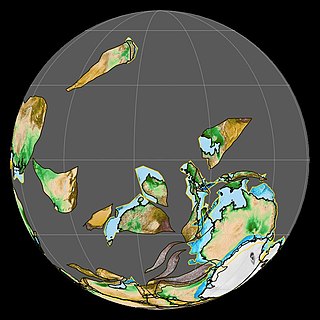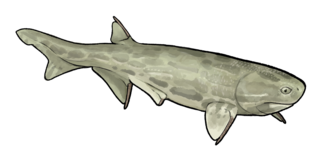
Chondrichthyes is a class of jawed fish that contains the cartilaginous fish or chondrichthyans, which all have skeletons primarily composed of cartilage. They can be contrasted with the Osteichthyes or bony fish, which have skeletons primarily composed of bone tissue. Chondrichthyes are aquatic vertebrates with paired fins, paired nares, placoid scales, conus arteriosus in the heart, and a lack of opercula and swim bladders. Within the infraphylum Gnathostomata, cartilaginous fishes are distinct from all other jawed vertebrates.

Acanthodii or acanthodians is an extinct class of gnathostomes. They are currently considered to represent a paraphyletic grade of various fish lineages basal to extant Chondrichthyes, which includes living sharks, rays, and chimaeras. Acanthodians possess a mosaic of features shared with both osteichthyans and chondrichthyans. In general body shape, they were similar to modern sharks, but their epidermis was covered with tiny rhomboid platelets like the scales of holosteians.

Placoderms are vertebrate animals of the class Placodermi, an extinct group of prehistoric fish known from Paleozoic fossils during the Silurian and the Devonian periods. While their endoskeletons are mainly cartilaginous, their head and thorax were covered by articulated armoured plates, and the rest of the body was scaled or naked depending on the species.

Cladoselache is an extinct genus of shark-like chondrichthyan from the Late Devonian (Famennian) of North America. It was similar in body shape to modern lamnid sharks, but was not closely related to lamnids or to any other modern (selachian) shark. As an early chondrichthyan, it had yet to evolve traits of modern sharks such as accelerated tooth replacement, a loose jaw suspension, enameloid teeth, and possibly claspers.

Orthacanthus is an extinct genus of fresh-water xenacanthiform cartilaginous fish, named by Louis Agassiz in 1843, ranging from the Upper Carboniferous into the Lower Permian. Orthacanthus had a nektobenthic life habitat, with a carnivorous diet. Multiple authors have also discovered evidence of cannibalism in the diet of Orthacanthus and of "filial cannibalism" where adult Orthacanthus preyed upon juvenile Orthacanthus. Synonyms of the genus Orthacanthus are Dittodus Owen, 1867, Didymodus Cope, 1883, Diplodus Agassiz, 1843, Chilodus Giebel, 1848.
Romer's gap is an apparent gap in the Paleozoic tetrapod fossil record used in the study of evolutionary biology, which represent periods from which excavators have not yet found relevant fossils. It is named after American paleontologist Alfred Romer, who first recognised it in 1956. Recent discoveries in Scotland are beginning to close this gap in palaeontological knowledge.

The Tournaisian is in the ICS geologic timescale the lowest stage or oldest age of the Mississippian, the oldest subsystem of the Carboniferous. The Tournaisian age lasted from 358.9 Ma to 346.7 Ma. It is preceded by the Famennian and is followed by the Viséan. In global stratigraphy, the Tournaisian contains two substages: the Hastarian and Ivorian. These two substages were originally designated as European regional stages.

Stethacanthus is an extinct genus of shark-like cartilaginous fish which lived from the Late Devonian to Late Carboniferous epoch, dying out around 298.9 million years ago. Fossils have been found in Australia, Asia, Europe and North America.

Acanthodes is an extinct genus of acanthodian fish. Species have been found in Europe, North America, and Asia, spanning the Early Carboniferous to the Early Permian, making it one of the youngest known acanthodian genera.

Symmoriiformes is an extinct order of stem-group holocephalians. Originally named Symmoriida by Zangerl (1981), it has subsequently been known by several other names. Lund (1986) synonymized the group with Cladodontida, while Maisey (2008) corrected the name to Symmoriiformes in order to prevent it from being mistaken for a family. The symmoriiform fossils record begins during the late Devonian. Most of them died out at the start of the Permian, but Dwykaselachus is known from the Artinskian-Kungurian of South Africa. Teeth described from the Valanginian of France and Austria indicate that members of the family Falcatidae might have survived until the Early Cretaceous; however, these teeth were also argued to be more likely neoselachian teeth.

Stethacanthidae is an extinct family of prehistoric holocephalians. It is estimated to have existed approximately between 380 and 300 million years ago. Members of this family are noted for their peculiar dorsal fin.
The Hangenberg event, also known as the Hangenberg crisis or end-Devonian extinction, is a mass extinction that occurred at the end of the Famennian stage, the last stage in the Devonian Period. It is usually considered the second-largest extinction in the Devonian Period, having occurred approximately 13 million years after the Late Devonian mass extinction at the Frasnian-Famennian boundary. The event is named after the Hangenberg Shale, which is part of a sequence that straddles the Devonian-Carboniferous boundary in the Rhenish Massif of Germany.

Symmorium is a dubious genus of extinct stethacanthid cartilaginous fish from the Devonian and Carboniferous of the United States (Illinois) and Russia. The type species, Symmorium reniforme, was named by Edward Drinker Cope in 1893 and several other species were originally classed under this genus, but they have since been classified into other genera such as Petalodus. Symmorium bears close similarity in size and appearance to Stethacanthus but the former is missing the "spine and brush" on its back. Some paleontologists think that the two forms are simply the males and females of related species, while other scientists think they were distinct genera.

Lissodus is an extinct genus of hybodont. While fossils attributed to this genus are known spanning from the latest Devonian (Famennian) to the very end of the Cretaceous (Maastrichtian), others consider the genus to have a more narrow range, spanning from the Early Triassic to the end of the Early Cretaceous (Albian). Lissodus is often placed in the family Lonchidiidae, though other authors consider it incertae sedis within Hybodontiformes. Lonchidion has often been regarded as synonymous, but many recent authors consider it to be a distinct but closely related genus.
Cladodus is an extinct genus of cartilaginous fishes in the family Ctenacanthidae. As the name implies, they are a type of cladodont, primitive sharks with teeth designed to snag fish and swallow them whole, instead of sawing off chunks to swallow.

Antarctilamna is an extinct genus of Devonian cartilaginous fish originally exemplified by Antarctilamna prisca from South Eastern Australia and Antarctica. The latest occurring described species is Antarctilamna ultima from the Waterloo Farm lagerstätte in South Africa. Antarctilamna has robust ctenacanthid-like spines which lack a deep insertion area, and are borne in front of the first dorsal fin; in addition to distinctive diplodont teeth with small intermediate cusps. Antarctilamna-like spines, known from the Bunga Beds locality in Australia have been ascribed to A. prisca.
Dwykaselachus is an extinct genus of symmoriiform, a cartilaginous fish that lived in what is now South Africa during the Permian period around 280 million years ago. It was first discovered in the 1980s, in a nodule of sediments from the Karoo Supergroup. Dwykaselachus was named based on Dwyka Group, the group of sedimentary geological formation in the southeastern part of Africa. It represents the place where the type species Dwykaselachus oosthuizeni was found.
Ozarcus is an extinct genus of symmoriiform cartilaginous fish from the Carboniferous period of Arkansas. The type species, Ozarcus mapesae, was named in 2014 based on cartilaginous skulls from the Serpukhovian-age Fayetteville Formation. The genus is named after the Ozark Mountains while the species was named after its discoverer, G. K. Mapes.

Ageleodus is an extinct genus of cartilaginous fish from the Paleozoic era. It is known from two species, both of which are based upon isolated teeth. A. pectinatus is known from the Carboniferous of Europe and North America. A. altus was described in 2006 from the Carboniferous of Australia. Four teeth from the Tournaisian deposits of Canning Basin probably present another Australian species although their shape is likely caused by physical wear rather than species features. This genus is also known from the Famennian of the Catskill formation at the Red Hill Site in Hyner, Pennsylvania. A study of 382 specimens from the site showed the strong heterodonty of this genus, which varies widely in tooth length and cusp number. This study described them as A. pectinatus, but the paper which described A. altus tentatively labeled them Ageleodus cf. A. altus. While generally considered a chondrichthyan, it has eluded classification into any known order or family.

Ctenacanthiformes is an extinct order of cartilaginous fish. They possessed ornamented fin spines at the front of their dorsal fins and cladodont-type dentition, that is typically of a grasping morphology, though some taxa developed cutting and gouging tooth morphologies. Some ctenacanths are thought to have reached sizes comparable to the great white shark, with body lengths of up to 7 metres (23 ft) and weights of 1,500–2,500 kilograms (3,300–5,500 lb). The earliest ctenacanths appeared during the Frasnian stage of the Late Devonian, with the group reaching their greatest diversity during the Early Carboniferous (Mississippian), and continued to exist into at least the Middle Permian (Guadalupian). Some authors have suggested members of the family Ctenacanthidae may have survived into the Cretaceous based on teeth found in deep water deposits of Valanginian age in France and Austria, however, other authors contend that the similarity of these teeth to Paleozoic ctenacanths is only superficial, and they likely belong to neoselachians instead.





















